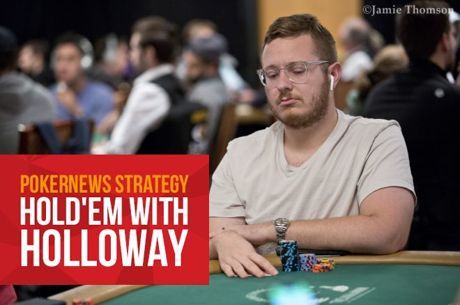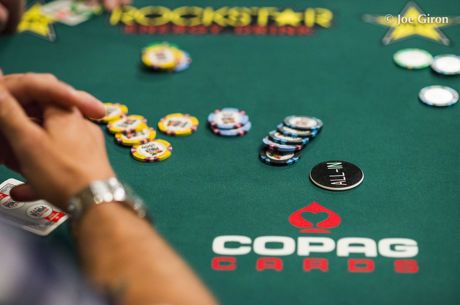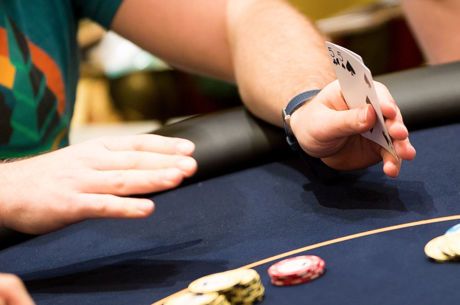Musing About 'M' and the Big Blind Ante
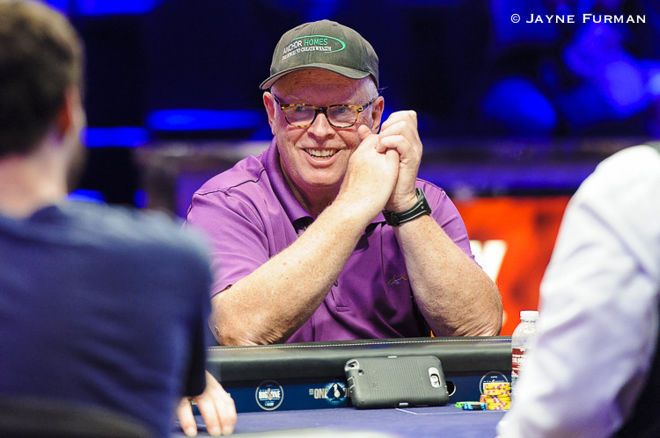
A huge part of no-limit hold'em tournament strategy concerns stack sizes and how the number of chips you have (and your opponents have) affects decisions you make. Since stack sizes are constantly changing in tournaments, they necessarily become a primary focus when it comes to talking tournament strategy.
Such an emphasis makes sense, if you think about it. The cards you are dealt, the cards your opponents are dealt, the board cards, and the significance of position all stay the same, but the changes in stack sizes are what cause big differences in how players should approach specific hands — that and the proximity of the payouts, which also changes as a tournament progresses.
Since stacks are so important in tournament poker, players have developed a handy shorthand for how to talk about them. Instead of referring to the number of chips we have, we talk in terms of how many big blinds we have left. Thus, when the blinds are 400/800 and we have a stack of 20,000, we say we started with 25 big blinds when analyzing a hand we played, and note as well how our primary opponent had 40 BBs or whatever it was.
The introduction of the big blind ante and its new popularity has caused me to think a little further about this habit of ours to describe stack sizes in terms of big blinds. Should the conspicuous presence of another "big blind" on the table at the start of a hand make us think differently about referring to our tournament stacks in terms of BBs?
I don't think so, really. But the question got me thinking a little about the recent history of tournament strategy and talking about stack sizes. It also caused me to reminisce about a tournament-related concept those of us who played back in the 2000s well remember — the "M."
The Landmark Harrington on Hold'em Books
When looking at the entire history of poker, tournaments are a relatively new phenomenon. They only really began to surface in the 1970s — that is, the first decade of the World Series of Poker. Other poker rooms gradually started offering tournaments and tournament series thereafter, and eventually some of the earliest strategy books focused on tournament poker began to appear.
Among the earliest were How to Win at Poker Tournaments (1985) by Tom McEvoy and some of McEvoy and T.J. Cloutier's later co-authored titles. Sklansky on Poker (1989) by David Sklansky had a section on tournament strategy as well, as was followed by a few more books by others during the 1990s targeting tournament players.
It really wasn't until the "boom" happened, though, that tournament strategy moved beyond the forums and into the mainstream via some books that sold quite well. The most popular tournament strategy books then (and probably of all-time) were the three Harrington on Hold'em volumes written by Dan Harrington and Bill Robertie.
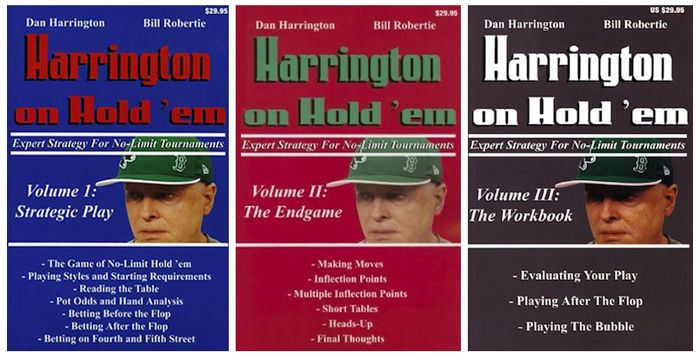
Appearing from 2004-2006, the Harrington books had a huge influence not only on tournament strategy but also on how subsequent strategy writers talked about tournaments and how to approach them. Even as thinking evolved and new concepts were introduced (e.g., "ICM" or the Independent Chip Model), Harrington and Robertie's approach to discussing tournament strategy had a lasting influence going forward.
Introducing "M"
Perhaps one of the most cited concepts from the Harrington on Hold'em books was presented in full in Volume 2. It was a way of talking about stack sizes designed to help players know what strategy to employ as the number of chips they hand changed.
The concept was called "M," the name having been used by Paul Magriel to refer to an idea that had in fact "been floating around the poker world for a long time." "M" was a number representing "the ratio of your stack to the current total of blinds and antes." The number theoretically indicated the number of orbits a player could last in a tournament if he or she folded every hand.
Paul Magriel sadly passed in early 2018. Read about his remarkable life here: "Poker Pro, Backgammon Champion Paul Magriel Dead at 71."
Say the tournament has reached the 10,000/20,000 level and the antes are 3,000, there are nine people at the table in this full ring event, and you have 570,000 in your stack. Your "M" would be exactly 10 (suggesting you could fold for 10 orbits and lose the blinds and antes along the way before busting).
To calculate "M" you had to add up the blinds (10,000 + 20,000 = 30,000) and the antes you'd spend during one full orbit (3,000 x 9 = 27,000), then divide your stack by that total (570,000 / 57,000 = 10). Harrington and Robertie suggested estimating your "M" before every hand, thus positioning you to know at every decision point what your relative stack depth was and thus how to approach playing the hand.
Late in tournaments the chip leader might have an "M" of 30 or 40, but in many cases most players will have a considerably smaller "M." And of course you don't want to fall down too low, as having an "M" of say 2 or 3 (or less) often makes it less likely you'll get a fold should you open-shove. You'd lose part of your "first-in vigorish" as Harrington and Robertie called it (today we talk instead about having "fold equity").
Could the BBA Bring Back the "M"?
"M" was pretty popular there for a few years, although by the early 2010s it had faded from usage as players more often simply referred to how many BBs they had.
I'm pretty sure the hassle of having to add up the antes before making the calculation of "M" was the primary reason that talk of stack sizes moved away from "M" and toward BBs. In that above example with 570,000 at the 10K/20K/3K level, it's a lot quicker just to say you have about 29 big blinds then to calcuate that your "M" is 10.
The "M" is a bit more precise of a ratio than BBs, really. Antes can be sized differently from tournament to tournament, and while the "M" would always adjust for that, just referring to BBs does not.
Of course, you have to be careful to adjust your thinking about the numbers when you do that, and adjust your strategy accordingly. Having an "M" of 10 might be relatively comfortable, but having 10 BBs is much less so. That said, talking in terms of BBs can make it easy sometimes to forget about the significance of having to pay the antes each hand — something "M" took into account.
The big blind ante is a one-time per orbit payment that more or less adds up to the amount a player would be paying one hand at a time over the course of an orbit. (It doesn't always add up that way, but that's the idea.)
I wonder if the introduction of the big blind ante might possibly bring back the "M" as a measuring tool for stack sizes in tournaments? It certainly makes calculating one's "M" a lot easier than it was before. If we're at the 10,000/20,000 level with a 20,000 big blind ante and I have a stack of 400,000, I can figure pretty quickly that I have an "M" of 8 — almost as quickly as figuring out I have 20 BBs.
It also seems like "M" could be a better way to refer to stack sizes than BBs once a tournament reaches a final table and becomes short-handed — i.e., when the BBA becomes even more significant in terms of how much it eats away from stacks every orbit.
I kind of doubt the "M" will come back, though. And if it did, I wouldn't be surprised to see the same idea resurface with a different name.
Dan Harrington was elected to the Poker Hall of Fame in 2010. Read about his induction here: "2010 Poker Hall of Fame Inductees Announced."
Conclusion
I remember about a decade ago having the good fortune to play in a charity event with "Action Dan." We were several hours into the tournament when Harrington was moved to my table. Alas, I didn't last much longer after he arrived.
It was a fast-structured tournament, and after a series of unfortunate occurrences I found myself short-stacked with an "M" of just 2 or so. I folded a few hands more (losing a few more antes), not wanting to bust. Finally I pushed in with king-ten suited and was knocked out just before a break.
By chance I got to talk with Harrington a little during that break. I joked with him about being embarrassed to be sitting there playing with him and having such a tiny "M." After all, I'd read Harrington on Hold'em — I knew better!
I still remember what he said.
"Sometimes ya look down and see deuce-seven and ya just can't bring yourself to play it," he shrugged.
He was right. Whatever way you might choose to describe your super-short stack, you're probably always going to look down at seven-deuce with similar disdain.

